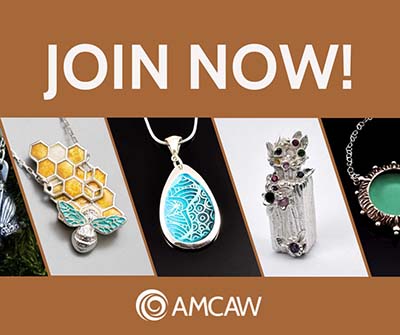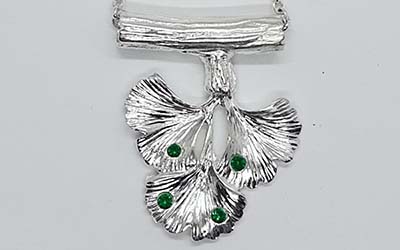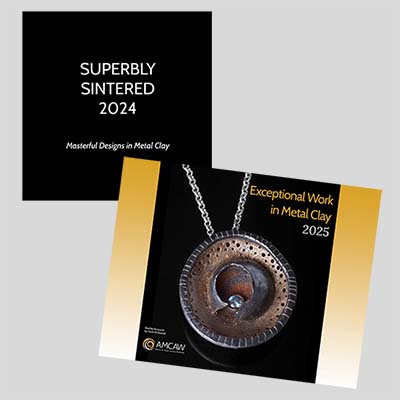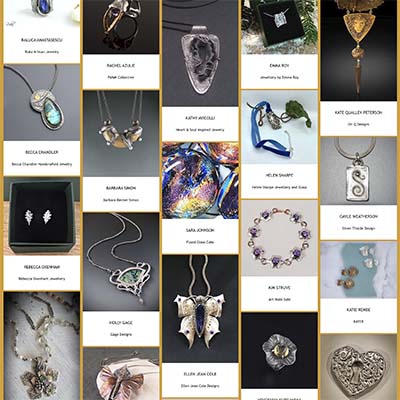There’s nothing scarier than your first artist show, is it? How do you price your items, how do you display them, how do you ring up sales, and how much do you talk to customers versus letting them just browse? It’s nerve-wracking!
But the toughest experience is getting THAT question: “Oh, is this metal clay? I want real jewelry.” My jaw dropped when I got that question during my very first show and the skeptic turned up her nose and walked away. That’s when I discovered that being prepared to speak confidently about metal clay is a core skill as a metal clay artist. The next show, I was ready with answers! I even had a handout, which became unnecessary as I grew more confident and was ready with my answers.
A confident metal clay artist understands that the average consumer is just uninformed; he or she simply doesn’t know what metal clay is. What works for me is smiling and saying “It IS a relatively new technology for fine jewelry, and not well understood yet. Did you know that…” then explain what metal clay is and why it’s great. Most people are surprised to learn that powder metallurgy is already a big part of their daily lives – from car parts to computer components to biomedical devices. Why not fine jewelry?
But sometimes I’m at a show with other jewelry artists, and then the issue is usually that the artist is misinformed. What I hear most often is a dismissive assumption that metal clay is inferior, and it’s prone to breakage. What a great hands-on opportunity this becomes to show the artist the quality of a good metal clay piece, and to share how metal clay is a great tool for every jeweler’s arsenal!
What most metal fabricators like most is metal clay’s versatility in coiling, carving, and sculpting. Silversmiths love that fine silver metal clay fuses to argentium without solder; argentium is very hot in the traditional metalsmithing world these days, and metal clay provides a way to make amazing embellishments and companion components for it. Metalsmiths also appreciate the recyclability of metal clay, and the faster speed of production we enjoy. It’s fun to watch their expressions as they start to become inspired!
This is just what works for me. Since AMCAW is all about sharing and helping each other, I’m sharing my Q&As and handout as Word documents below in case you’d like to borrow parts or modify them for yourself or your students. We can’t always create raving converts, but every positive, confident conversation moves the needle a little bit closer to building a true picture of our exciting medium.
Metal Clay Q&As: Know Before You Show!
Knowing in advance how to respond to customer questions will help you reply confidently when asked about metal clay. Here are some possible Q&As which may help you address customer questions.
Q: What is metal clay?
A: Metal clay is made by mixing powdered metal with a small amount of inert organic binder and moistening it to attain a malleable, clay-like consistency. This new clay-type format allows artists to work with precious metals in innovative ways that can’t be done with traditional metalsmithing techniques. It can be rolled, coiled, carved, and sculpted in myriad ways, and even used in 3D printing.
Once transformed into a work of art, the metal clay is dried and refined, then fired, usually in a kiln, to just below the melting point of the metal used. The small amount of binder burns out, causing the piece to shrink slightly and the metal molecules to sinter together tightly. Depending on the type of clay, it can form an almost pure metal like fine silver, or an alloy such as sterling silver. Metal clay is available in almost any metal: gold, silver, copper, bronze, iron, steel, and more.
Q: Where does metal clay come from?
A: Most metal clay is made from recycled metals; the necklace you buy today might have started life as silver flatware. Metal clay is sourced and manufactured all over the world.
Q: Is this something brand new?
A: It’s a new development in making fine jewelry, but the technique of powder metallurgy has been around for thousands of years. In fact, the ancient Egyptians were among the earliest to reduce metal to granules or powder when they powdered iron. It’s been used through the centuries commercially, and it’s already a part of your daily life – from car parts to computer components to biomedical implants. However, it was only in the 1990s that powdered metal became available as metal clay for making jewelry.
Q: I’ve heard that metal clay pieces are brittle.
A: When properly sintered, metal clay is strong, but it has a different level of strength as its production doesn’t include pressure like forging, or melting like casting. Just as diamonds are harder than sapphires or pearls, and yet all three are valued by jewelers for creating stunning jewelry, metal clay is a valuable tool in any jeweler’s creative arsenal for its versatility.
Q: If metal clay jewelry is so easy to make, why isn’t it cheaper than other jewelry?
A: Metal clay jewelry is neither more nor less expensive than other forms of handmade jewelry. Although the material itself is more expensive to buy than traditional metals due to the labor required to manufacture it, metal clay doesn’t demand an investment by the artist in large tools and equipment, like rolling mills, hydraulic presses, casting equipment and other considerations. When both labor and tools are added to the materials cost, the cost of traditional fabrication and metal clay forming are very similar. The true worth of any handmade work comes in the skill and imagination of the maker, and the appreciation of the buyer.
Q: I’m a metalsmith. Since I already work with metal, why would I be interested in metal clay?
A: There are so many reasons!
If you work in fine silver or argentium, you’ll want to explore fine silver metal clay. You can make amazing components for your jewelry by carving, coiling, or sculpting – and they will fuse to your fine silver or argentium components without solder.
If you’ve created jewelry by casting, you’ll know how many steps are involved in the process and how long it takes. With metal clay, you can carve the medium directly, and fire it as soon as it’s refined and dried. It’s possible to carve, refine, dry, and fire a piece in a day. When you’re working under a deadline, metal clay is your friend!
Metal clay is made of recycled materials, and there’s next to no materials waste during production. With the jewelry industry focused on sustainability and recycling, metal clay becomes a strong choice for the future.
These answers have worked well for me. As I’ve become more comfortable with the conversations, the responses have flowed more naturally. As always – if you have better ways to answer this type of question, please share your best practices with us!
Click here to download a metal clay flyer you can customize.
By Martha Vaughan – GUEST BLOGGER
Guest Artist Blog
This is an op-ed article representing the opinions of the guest blogger, and is not intended to represent AMCAW. Do you have a best practice, interesting idea, tip, or story to share? You could be our next guest blogger! Email us at hello@amcaw.org with a brief description of your proposed blog topic and put “Guest Blog Idea” in your subject line.













